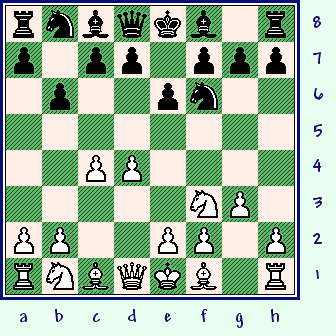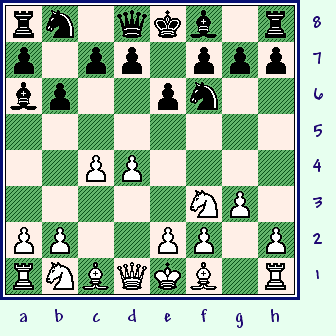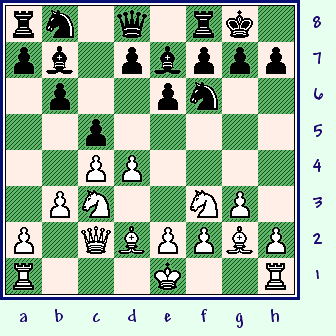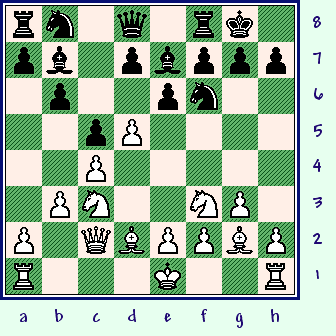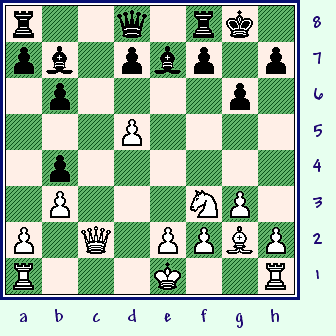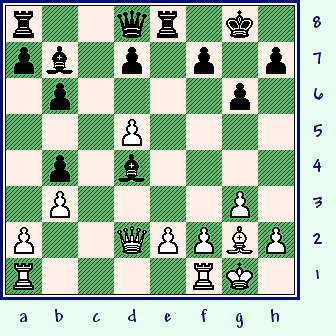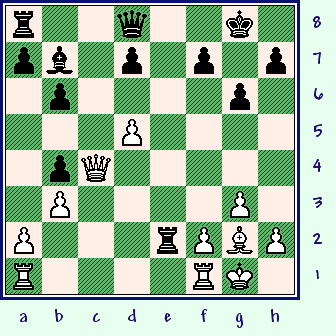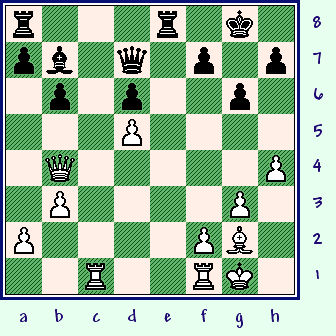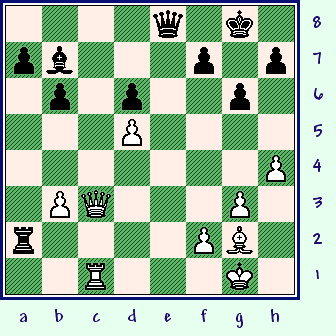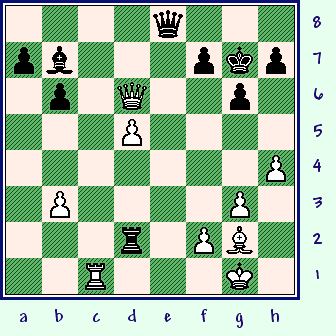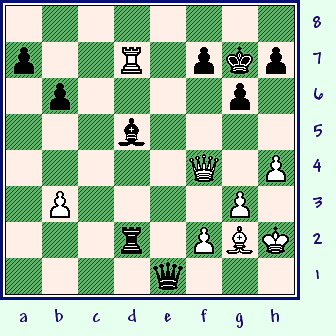GM Vicktor Korchnoi (2615) -
GM Alexander Beliavsky
(2599);
|
|
|
My "Game of The Month" for the period for September, 2005. (Cf. TWIC # 563.)
Here is an interesting chess game ...
from one of my all-time favorite players. (He was one of the best players in the world, and was a top,
important, key figure in the chess stratosphere from the 1950's to the 1990's.) He may be one of the best
players ... to never have won a World's Championship, and certainly has one
of the longest chess careers of all time. (Of the other great players, only
Emanuel Lasker
played as well, late in his distinguished chess career.)
-
I also have many books (around eight) on Korchnoi, but it is definitely a joy to see a new creation of his.
(This game also tackles another problem, one of the few consistent complaints I receive, as concerns this column, is that I do too many KP Openings ... and also I like to look at the Sicilian as well. Here is a well annotated QID for your enjoyment and for you to study.)
****************************************************************************************
1.d4 Nf6;
2.c4 e6; 3.Nf3, (controls the center)
A natural developing move that also avoids the pin by Black's Bishop. (On the a5-e1 diagonal.)
[ After the moves:
3.Nc3 Bb4;
we have a Nimzo-Indian Defense.
(Another completely new opening system, that was worked out almost
entirely by the great hyper-modern player, Aaron Nimzovich.)
See last month's column,
(Aug. 2005) ... for a game that features
...
The Nimzo-Indian opening system.
]
3...b6;
(Q-side fianchetto)
The Queen's Indian Defense.
This opening was pioneered by the Hyper-modern players ... mostly the great Aaron Nimzowitsch.
Although many Classical players did not readily take to this opening - many openly laughed at Nimzovich, and held his "new fangled openings" in complete contempt - the new ideas could not be suppressed. (Today, this opening is seen as acceptable, and ... of course! ... completely normal.)
I (now) have literally about 2 dozen books on this opening in my library. I have studied this opening quite a bit, and it was not really by choice. There was a period
... probably during the 1980's ...
when this opening seemed to completely dominate master-level chess. I was present, (as a spectator!); at two or three U.S.
Championships during this period, and this was often the opening that was played more than any other.
I have the book, "The Queen's Indian, A Quantitative Analysis of The Opening," from the program conceived by David Levy, Kevin O'Connell, and David Watt. (Publisher: Imprint Capablanca, printed in 1981 and 1982.) There is a flyer (fold-out) in that book by GM Andy Soltis, it often transpired that this opening was played over 80% of the time at the GM level!!! {This was true just in some <isolated> events, but obviously did not apply to every tournament that was played during that period.}
Today, this is one of Black's most solid of all openings, and is played by every class of player ... from the lofty GM, all the way down to the class {and club} players- who compete mostly just for fun. (As opposed to GM's, for them chess is a profession.)
4.g3,
('!?' ... maybe - '!')
The Classical System? {See
the diagram, just below.}
The system of a "counter-fianchetto" that was first worked out by none other than the great player and opening pioneer,
GM Akiba Rubinstein. [More
on this great player,
his life
and games
- plus, maybe his greatest game.]
*************************************
*************************************
rnbqkb1r/p1pp1ppp/1p2pn2/8/2PP4/5NP1/PP2PP1P/RNBQKB1R
Originally viewed as somewhat iconoclastic, it was later accepted into mainstream theory. (There was a period for over 50 years where any person using this opening, from the Black side of the chess board, could expect to see g3 on move four - perhaps 95 times out of a hundred; especially at the master level.)
Today, the opening formation (for White) that begins with the move 4.g3, is viewed as one of two or three of the most solid and reliable of the variations that White can choose from, when playing against The Queen's Indian Defense.
[ One of the main lines, with the move a3,
{on White's third or fourth turn}; is the following continuation:
4.a3!? Bb7; 5.Nc3 d5;
6.cxd5 Nxd5; 7.Qc2 Nxc3; 8.bxc3 Be7;
9.e4 0-0; 10.Bd3 c5; 11.0-0,
"+/="
White has a solid edge.
A good game, from a rather recent event would be:
GM Z. Kozul - GM V. Bologan;
ICT / XXXV Bosnian Masters /
Sarajevo, BIH; 2005. (0-1, 46.)
This is an amazing game, well worth your deepest studies. (A wild opening. Black sacked a Pawn for play,
then got it back. A see-saw struggle then ensued, and White appeared to be on the verge of winning, by pushing
a center Pawn straight up the middle of the board. I won't tell you how the game ended, hopefully I have {now}
aroused your curiosity enough that you will examine it on your own.)
[ See also MCO-14, the section on
"The Petrosian System," pages # 555-565.
All columns and applicable notes.
]
A good game to study, in connection with the systems that features a3 for White, would be my
web page
on
Kasparov-Portisch, Niksic;
1983. ]
4...Ba6!?;
(Bishop on the edge of the board?) {See
the diagram given - just below.}
An interesting move that was also one of Nimzovich's original ideas.
(It seems to run counter to conventional chess wisdom, normally when you push your Knight's Pawn one square, you will develop the Bishop to the "Knight-Two" square ... on the long diagonal. Here, the idea is to attack the White c-Pawn. (Playing)
Pawn-to-e3 closes in White's dark-squared Bishop and does not fit in well with the move, 4.g3. Practice has clearly demonstrated that it is not easy
for White to meet the threat to the foot-soldier on c4. Nbd2 is less than an ideal development, and b3 blocks off White's Queen from being able to easily access the Q-side.)
*************************************
*************************************
rn1qkb1r/p1pp1ppp/bp2pn2/8/2PP4/5NP1/PP2PP1P/RNBQKB1R
This is an unusual chess position, and a good place for a diagram.
[ For the continuation of:
4...Bb7; 5.Bg2 Be7;
6.0-0, "+/=" 6...0-0,
please see
MCO-14. (Page # 566, columns # 19-24, and all notes.)
A good, recent example would be:
H. Elwert - D. Fleetwood; (1-0) /
Corres. /
18th World Champ; 2004.
(White won in 46 precise moves.)
*** *** *** *** *** *** *** *** *** *** *** *** *** *** *** *** *** ***
A great - classical - battle would be:
J.R. Capablanca - Alexander Alekhine; /
World Champ. Tourn. / A.V.R.O.
Amsterdam, NED; 1938. {A draw in 48 moves.} ]
5.b3!?,
(A simple solution.)
Perhaps the most practical move for White, and one that shows a certain amount of economy.
[The first player protects a Pawn with a Pawn, and basically says to Black, ...
(Now) "Your Bishop looks funny {misplaced} on the a6-square."]
[ White could also try:
5.Nbd2 Bb7; {Diagram?}
Now that the c4-point is protected, there is no point in leaving the
B stranded on a6.
6.Bg2 c5; 7.e4 cxd4;
8.0-0 d6; 9.Nxd4,
"+/=" with a small but secure edge.
G. Tallaksen (2326) -
A. Greet (2403); /
GMB / Gausdal,
NOR; (1) / 13,04,2005.
{White won a nice game.}
[ See also MCO-14, page # 570; column # 35 plus applicable notes. ] ]
Black's next move probes his opponent ... and hopes to exploit White's {slight} weaknesses on the dark squares,
(on the Queen-side).
5...Bb4+;
6.Bd2,
Seemingly an awkward move, but it is really the best reply for White.
[ </= 6.Nbd2?! Bc3; "<=>" ]
6...Be7;
('!') Strategic retreat.
Exchanging the Bishops leaves White with the better game. Black basically says that d2 is not all that great a square for White's QB, and more or less hinders the first party's overall development.
[ Probably not as good would be:
</=
6...Bxd2+!?;
7.Qxd2 0-0; 8.Bg2,
"+/=" (more space/plus center)
with a solid advantage to White.
]
7.Nc3 Bb7;
(Time loss? ... & why?)
Black does not wait, and since this piece {now} serves no useful purpose, he immediately redeploys this unit to a much more useful square. {On the standard 'long diagonal,' note Black's current control of e4 - this is a very critical square in most variations of this opening.}
[ Instead, one standard reference work gives the continuation:
7...0-0; 8.e4 d5;
9.cxd5 Bxf1; 10.Kxf1 exd5;
11.e5 Ne4; 12.Kg2 Qd7;
The end of the column ... which is a traditional place to try and reach an evaluation
for the basic position that is reached out of the opening here.
13.Qe2 Nxc3; 14.Bxc3 c5;
This is the main 'try' here.
** ** ** ** ** ** ** ** ** ** ** ** ** ** ** ** ** ** ** ** ** ** ** ** ** ** ** ** ** ** ** **
( After the continuation:
(</=) 14...Nc6!?; 15.Rhe1 Nd8;
16.Ng1! c5; 17.f4 cxd4!?; 18.Bxd4 Qf5;
19.Rad1 Bb4; 20.Rf1 Ne6; 21.Qd3! Qxd3; 22.Rxd3 Rac8; 23.Nf3,
"+/=" {D?}
White had a small, but solid edge, and went on to win a very nice battle.
(Near-perfect, definitely a model game.)
GM A. Karpov - GM And. Sokolov; / FIDE Candidates {final} Match (G #10)
[See Inf. # 43/670, by M. Podagaets.] /
Linares, ESP; 1987. (1-0, 63 moves.)
To see the full game / download the PGN score / or replay the game, ...
please see the following link: http://www.chessgames.com/perl/chessgame?gid=1068569.
)
** ** ** ** ** ** ** ** ** ** ** ** ** ** ** ** ** ** ** ** ** ** ** ** ** ** ** ** ** ** ** **
15.Rad1 Nc6; 16.Rd2!? Qe6;
17.Rhd1 Rfd8; 18.Ng1!? Rac8; 19.Nh3!,
"~" {Diag?}
MCO considers this position as solidly better for White, and Fritz awards a slight edge to Black.
(Therefore, I diplomatically choose the evaluation that lies
between the other two.)
See the GM contest:
J. Hjartarsson - S.B. Hansen; ICT /
Aruna Masters
(1-0, 56.)
Copenhagen, DEN; 1997. {White won a nice game in 56 total moves.}
[ Please see: MCO-14, page # 570; column # 31, and especially note # (c.). ] ]
Both sides continue to develop their pieces ... in a relatively normal fashion, especially for this opening.
8.Bg2 0-0;
9.Qc2 c5; (lever) {See
the diagram given ... just below here.}
Black breaks in the center, not wishing to allow White too much time to build up a big center.
(A standard strategy for the first party is to try and play d4-d5, and block Black's QB out of the game.)
*************************************
*************************************
rn1q1rk1/pb1pbppp/1p2pn2/2p5/2PP4/1PN2NP1/P1QBPPBP/R3K2R
Black's two standard breaks in this opening system are ...Pawn/c7-c5; and also ...Pawn/d7-d5.
As to which one is correct, I think it is as much a matter of taste and style as much as any chessical factor.
(Some masters like blocked positions, and some don't.)
[ Black can also play:
(</=)
9...d5!?; 10.0-0 Na6!?; 11.cxd5!? exd5!?;
(hmmm)
Maybe not the most accurate.
( >/= 11...Nb4!; 12.Qb2 Nbxd5; "~" )
12.Rfd1,
hmmm
A nice centralizing move ... but is it sharp enough, (and the most accurate?); ...
and will it really guarantee White an advantage?
A good, interesting game - that I have studied in some detail - is the nice GM contest:
V. Eingorn (2570) -
K. Aseev (2545);
/ (FIDE?) Lvov Zonal Tournament
/
L'viv, Ukraine; 02,1990.
( Also possible was: 12.a3!?, "~" with the idea of b3-b4. ("+/=" ?) )
Now we follow a line ... that was given by several different sources, most notably:
"New In Chess."
12...Qc8; 13.Bf4,
('!') {Diagram?}
This could be best.
*********************************************************************
( The aforementioned game, between the two GM's, went:
13.Bg5!? Rd8; 14.Ne5 c5!?;
15.Rac1 h6; 16.Bxf6!? Bxf6; 17.e3 Nc7!?;
Playing 17...Qe6; looked simpler.
18.f4 cxd4; 19.exd4 Be7!?; A loss of time? (Looks like it.)
20.Qe2 Qe6; 21.Qh5 Ba3!?;
22.Rc2 Ne8?!; ('?')
Simple moves ... like putting the Rook on e8 ... makes sense, and appeals to both Fritz and I.
23.Nb5! Bd6; 24.Nxd6 Rxd6;
Taking with the Knight was to be seriously considered here.
25.Re1 Rad8!?; 26.Rce2, Nice, but ...
( Probably better was: >/= 26.f5! Qe7;
27.Rce2 Nf6; This could be forced.
28.Qxf7+! Qxf7; 29.Nxf7 Kxf7;
30.Re7+ Kf8; 31.Rxb7, '±' ("+/-"
?)
and White has an extra Pawn. )
26...Ba6; 27.Nc4! Qxe2;
28.Qxe2 dxc4; 29.d5!?,
'±' {Diagram?}
White had close to a won game, but later went astray. (0-1, 43
moves.)
V. Eingorn - K. Aseev; / Lvov zt / UKR / 02,1990. )
*********************************************************************
13...Rd8; 14.Qb2!?;
A little bit of a passive play by White here.
( >/= 14.a3!, with the idea of b4, in order to discourage Black from playing ...P/c7-c5. )
14...h6; 15.Ne5 c5;
16.Nb5!? Qe6!; "~" {Diagram?}
Now White can play Rac1 or dxc5 ... with
maybe a slight edge.
This is also the contest:
R. Bjerke - J. Hjartarson; /
ICT, Eikrem Memorial Tourn. /
Gausdal, NOR; 1996. (0-1)
{Black won in 33 moves.} ]
10.d5!?N,
(Probably - '!')
{See the diagram given - just below.}
This is certainly a thematic move for White in these types of positions.
(White gains space and hopes to jam Black's QB, perhaps blocking it completely out of the game.)
*************************************
*************************************
rn1q1rk1/pb1pbppp/1p2pn2/2pP4/2P5/1PN2NP1/P1QBPPBP/R3K2R
As far as I could determine, this move is new to master-level practice.
[ White can also play:
10.dxc5 bxc5!?; 11.0-0 d6;
12.Rad1 Nc6; 13.Bg5,
"~" ("+/=")
with perhaps a slight edge for White in this position.
S Tatai - O. Borik; /
ICT, Masters /
Dortmund, GER; 1981.
{A quick draw ... in only 21 total moves.}
I should also point out that there are almost NO GM games (!) with
the position after 13.Bg5, {above}; which means that there is a lot of
room for experimentation ...
and also (obviously) room for some improvement as well.
**********************************************************
White possibly could also try:
10.0-0 cxd4; 11.Nxd4 Bxg2;
12.Kxg2 Qc7; 13.Qd3 Na6;
14.Ndb5 Qc6+; 15.Qf3,
"~" {Diagram?}
with maybe just a slight edge for White in this position.
("+/=")
M. Johansen - J. Nilssen; /
Corres. 98-99 / DEN, ChT / 1998.
{A long game ... that was eventually drawn, in eighty difficult moves.}
]
The next few moves could be seen as being close to best, and conform to certain rules of chess logic.
(If the second player allows White to stuff his Queen's Bishop - without penalty - then this equates to a definite edge for White.
So GM A. Beliavsky does everything in his power to prevent Korchnoi from achieving his goals ... unhindered.)
10...exd5!?;
11.Ng5! Nc6!; 12.Nxd5! g6[];
This move is the first choice of several computer programs, and at first I thought it was questionable, as Black's dark squares are
now slightly weakened. But after I looked at the position for just a short time, I realized that the move was forced, as White threatened
taking on f6 ... followed by QxP/h7+, winning.
[ But ... of course not: </= 12...Nxd5; ('???') 13.Qxh7#. ]
The next few moves are relatively best.
(White voluntarily retreats his Knight, Black {now} has the threat of NxN/d5, followed by BxN/g5; winning a piece.)
13.Nf3 Nxd5;
14.cxd5 Nb4!?; 15.Bxb4 cxb4; "~" {Please
see the diagram - just below.}
This is an interesting position, most programs award Black a solid edge.
(Around " - 0.35" at this point. However, I doubt the assessment of the boxes here, there seem to be many factors,
especially as those that touch upon the endgame; that the programs do not seem to have taken into account.)
*************************************
*************************************
r2q1rk1/pb1pbp1p/1p4p1/3P4/1p6/1P3NP1/P1Q1PPBP/R3K2R
White has given up his dark-squared Bishop, but also has succeeded in fixing a Pawn on the d5-square.
16.Qd2 Re8;
17.0-0 Bf6; 18.Nd4 Bxd4!?; (hmmm) {Diagram
- just below.}
Black gives up his best piece ... and temporarily wins a Pawn.
*************************************
*************************************
r2qr1k1/pb1p1p1p/1p4p1/3P4/1p1b4/1P4P1/P2QPPBP/R4RK1
Personally, I am not sure about this whole conception here by GM Beliavsky.
---> Once White regains the button, he seems to have the strategically superior game.
('?!')
However, I should point out that Black was probably bothered about Korchnoi's Knight staying on d4 ...
long term.
(Black probably must eventually play ...d7-d6. If this is true, then Black would have to be gravely concerned that
White might play
N/d4-c6, with a large edge.) So perhaps Beliavsky was justified in removing this piece immediately.
[ The move of:
(>/=)
18...a5!?;
"~" {Diagram?}
was to be seriously considered here for Black. (Whether this is absolutely an improvement
over the course of the game or not ... I really can't say, not with any degree of certainty.)
]
19.Qxd4 Rxe2; 20.Qc4!, (tempo)
{See the
diagram given here - just below.}
Before winning the Pawn, White forces back Black's Rook.
*************************************
*************************************
r2q2k1/pb1p1p1p/1p4p1/3P4/1pQ5/1P4P1/P3rPBP/R4RK1
Most computer programs fail to grasp the point of this move ... this is the difference between tactics and strategy!
[ (</=) 20.Qxb4!? Qf6; "~" ]
20...Re8;
(Best?) [A
key position - for the early middle-game - has been reached.]
Now White is simply better, perhaps Black had to seek continuing 'fun' (complications) by playing his Rook to the b2-square.
(Beliavsky may have been concerned that his lone Rook might eventually be cut off, surrounded, and then captured ...
which is probably why he did not play in this fashion.)
[ Not </= 20...Qe7?; as 21.d6!, "+/-" wins handily for White. ]
21.Qxb4 d6;
22.Rac1 Qd7!?;
This is OK, although ...Re2; or even ...a5; both looked playable.
(22...Rc8; might have been the simplest solution.)
[ Perhaps Black could try:
22...Qf6!?; {Diagram?}
At first, this looks inadvisable ... as White is allowed to land a Rook
on the vital seventh rank. But I see no (immediate) forced win for
White.
23.Rc7 Ba6; This is interesting.
( Or
23...Re7!?; 24.Rxe7,
(Probably best.)
( </= 24.Rfc1? Rxc7; 25.Rxc7 Qa1+;
26.Bf1 Ba6; "-/+" )
24...Qxe7; 25.Re1 Qf6;
26.h3 Rc8; 27.Qd2,
"+/=" ("~"
?) )
24.Re1 Rxe1+; 25.Qxe1, "+/=" 25...Bb5; "~" with continuing complications.
(Fritz evaluates White as a fuzz better, yet I played around with these positions for close
to half hour ... and never found anything remotely resembling a big, forced advantage ...
or anything that is even close to a win for White.)
]
23.h4!, (creating a possible lever) {See
the diagram of this position, given just below here.}
This move does a number of good things for White:
# 1.) It allows White freedom from having to play Bf1 after any Rook or Queen checks. (back-rank);
# 2.) It gains space & hits g5;
# 3.) Korchnoi threatens stuff like h4-h5, followed by capturing on g6, (weakening the P-structure around the Black King);
or even playing the White RP all the way down to the h6-square. (Which would create mating webs and/or some
back-rank problems for Black.)
*************************************
*************************************
r3r1k1/pb1q1p1p/1p1p2p1/3P4/1Q5P/1P4P1/P4PB1/2R2RK1
Alekhine played this idea on a number of occasions. Yet it was GM B. Larsen who practically patented this move,
using it in many of his best games, and he {also} played it from both sides of the chessboard. {As White & Black.}
[ 23.Rfe1!?, "+/=" - Fritz 8.0 ]
The next series of moves seems to be fairly straightforward.
23...Re5;
24.Qd4 Rc8; 25.Rxc8+ Qxc8; 26.Qd2,
This move keeps Black's heavy pieces off of White's (crucial) second rank.
[ The move: 26.a4!?; poses almost no real problems for Black here. ]
26...Qe8;
(doubling on the e-file)
This is playable, (and even logical) for Black. (Threatens ...Re2.)
[ Or 26...Qf5!?; 27.Rc1, "~" ]
Now White deliberately gambits a Pawn.
(Playing a2-a4 would have avoided losing the button on the a2-square, but probably only would have resulted in a draw.)
27.Rc1!!, (natural)
It is almost always good to grab an open file with a Rook.
(27.Qb4!? was another idea worth exploring in this position.)
This is an extremely good move by the great Korchnoi ...
he has done a wonderful job in assessing all the possibilities that arise from here.
Normally - I would not award a fairly obvious move a double-exclam, but here it is fully deserved.
(White gambits a button ... at least temporarily, and also allows Black to create some very real threats against the White King.
If Korchnoi had not accurately judged the resulting positions, he risked losing the game.)
[ The other possibility for White was:
27.a4!?,
to keep the BQ off the b5-square,
and remove the a2-Pawn from any latent threats by the Black Rook on the 7th rank.
(White's second row is Black's 7th.)
]
27...Re2;
28.Qc3 Rxa2?!; (Maybe -
'?')
{See the diagram - just
below here.}
The first real inaccuracy of the game.
*************************************
*************************************
4q1k1/pb3p1p/1p1p2p1/3P4/7P/1PQ3P1/r4PB1/2R3K1
At first glance, it looks OK to grab this button. However, it allows the great Korchnoi a chance to gain the initiative.
(Once the WQ gets to the f6-square, it is very hard for Black to do anything constructive.)
After a move like 28...Qe7; it is hard to see how White could make any real progress.
[ Black should have played: >/= 28...Re5!; "~" Probably equal. ("=")
For example:
29.Qc7 Bxd5!; 30.Qxd6! Re1+!; 31.Rxe1 Qxe1+;
32.Kh2 Bxg2;
33.Kxg2 Qe4+; 34.Kh2 Qc2;
"=" {Diagram?}
when neither side can claim any
real advantage in this ending. {A balanced pawn structure.}
]
29.Qf6,
(Maybe - '!') -
(Piece activity!)
White naturally occupies one of the 'holes' in Black's Pawn shield, (near the Black King!) ... ... ...
note that the White Queen does double duty on this square, it helps protect the f2 point as well.
[ </= 29.Qc7? Qe2; 30.Rf1 Ba6; "/+" ]
29...Rd2;
('!?')
Playing 29...Qf8; was also to be considered here for Beliavsky.
30.Qxd6,
"+/=" 30...Kg7; ('!?')
{See the diagram ... given just below.}
It would be very easy to criticize this move, the evaluations swing rather dramatically - after this play by Black.
*************************************
*************************************
4q3/pb3pkp/1p1Q2p1/3P4/7P/1P4P1/3r1PB1/2R3K1
However, I spent almost two hours one afternoon - always with at least one engine churning away in the background - looking for a way out for Black from this position. ---> I never found a line that would offer Black definite salvation.
Probably the best defense is to simply push one of the RP's forward two squares ... and pray. However, to find this line, you would have to be {nearly} a computer ... with only ice-water running in your veins!
Please note that the current formation, after White captures on d6 and gains a passed pawn, are very favorable for Korchnoi. This makes GM Beliavsky's defensive task difficult ... ... ... if not just plain impossible!
[ Was the try of: 30...h6!?, {Diag?} any better? (Maybe, maybe not.) ]
31.Qf4! Qe2;
At first glance - this appears to be an error.
Yet close analysis should show that Black's game may already be beyond saving ... at this point.
[ Or 31...Re2!?; 32.Rc7, '±' ("+/-") ]
32.Rc7 Qe1+;
33.Kh2 Bxd5!?;
Going over this game ... the first time, without any computer assistance ... I thought that this move might be just a mistake by Beliavsky. But with the help of Fritz ... I quickly discovered that Black really does not have anything substantially better here.
White just has too many threats here, Black's Bishop on b7, the Pawn on f7 and his Rook on d2 all are exposed to attack.
(Which is why Black cannot play his Queen to the e8-square in this position, he simply drops the BR on d2.)
[ </= 33...Rxf2?; 34.Rxf7+ Kg8; 35.Qxf2 Qxf2; 36.Rxf2, "+/-"
</= 33...Qe8?; 34.Qxd2, "+/-"
</= 33...Ba6??; 34.Qxf7+ Kh6; 35.Qxh7#. ]
Now Black seems to have all his weak points - like f7 - covered, but a simple pin decides everything.
34.Rd7,
('!')
"+/-" Black Resigns. {See the final
diagram ... just below.}
(White threatens to win a piece by taking on d5. If Black tries the capture, ...BxP/b3; then RxR/d2 wins. Black could try the slightly tricky 34...BxB/g2?? here, {this usually only works when your opponent is extremely short of
time};
hoping that White would immediately grab the Rook - and Black could then respond with 35...Qh1#. And if 35.KxB??, then Black wins by taking White's Rook. However, 34...BxB/g2??; is neatly refuted by 35.QxP/f7+, with a quick mate to follow. And finally, 34...Qe6!?; is turned back by
35.QxR/d2, when 35...QxR/d7; 36.QxB/d5, leaves White a whole piece ahead, with an easy win.)
*************************************
*************************************
8/p2R1pkp/1p4p1/3b4/5Q1P/1P4P1/3r1PBK/4q3
Truly elegant play by Korchnoi!!!
I would rank this among Korchnoi's greatest masterpieces!
The difficulty level of this game belies the seemingly simple positions and moves that occur in the game! Even with days of work - and using several different computer engines - I was not always able to quickly or easily determine the 'truth' about this monstrously complex chessical battle!!
Copyright (c) A.J. Goldsby, 2005. All rights reserved.
